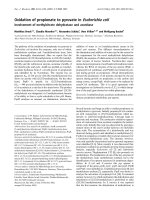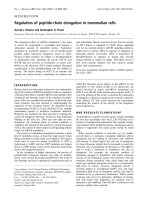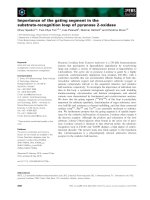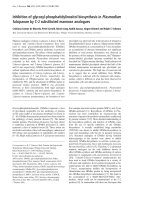Báo cáo y học: "Importance of basophil activation testing in insect venom allergy" pdf
Bạn đang xem bản rút gọn của tài liệu. Xem và tải ngay bản đầy đủ của tài liệu tại đây (235.61 KB, 4 trang )
BioMed Central
Page 1 of 4
(page number not for citation purposes)
Allergy, Asthma & Clinical
Immunology
Open Access
Review
Importance of basophil activation testing in insect venom allergy
Mitja Kosnik* and Peter Korosec
Address: University Clinic of Respiratory and Allergic Diseases, Golnik, Slovenia
Email: Mitja Kosnik* - ; Peter Korosec -
* Corresponding author
Abstract
Background: Venom immunotherapy (VIT) is the only effective treatment for prevention of
serious allergic reactions to bee and wasp stings in sensitized individuals. However, there are still
many questions and controversies regarding immunotherapy, like selection of the appropriate
allergen, safety and long term efficacy.
Methods: Literature review was performed to address the role of basophil activation test (BAT)
in diagnosis of venom allergy.
Results: In patients with positive skin tests or specific IgE to both honeybee and wasp venom, IgE
inhibition test can identify sensitizing allergen only in around 15% and basophil activation test
increases the identification rate to around one third of double positive patients. BAT is also
diagnostic in majority of patients with systemic reactions after insect stings and no detectable IgE.
High basophil sensitivity to allergen is associated with a risk of side effects during VIT. Persistence
of high basophil sensitivity also predicts a treatment failure of VIT.
Conclusion: BAT is a useful tool for better selection of allergen for immunotherapy, for
identification of patients prone to side effects and patients who might be treatment failures.
However, long term studies are needed to evaluate the accuracy of the test.
Introduction
Up to 0.1% of the population suffers from severe anaphy-
laxis after Hymenoptera insect sting. The prevalence is
even higher in beekeepers, where can exceed 4% [1].
Venom immunotherapy (VIT) is the only effective treat-
ment for prevention of serious allergic reactions to bee
and wasp stings in sensitized individuals. However, there
are still many questions and controversies regarding
immunotherapy, like selection of the appropriate venom
in patients with double positive tests or of patients with
allergic reactions following European hornet stings,
patients with negative sIgE and skin tests, detecting the
patients at risk for side effects during immunotherapy and
detecting the patients at risk of relapse after stopping
immunotherapy [2].
Patients with positive allergy tests to both
honeybee and wasp venom
Up to 50% of patients with sting reactions have positive
routine diagnostic tests (skin tests, specific IgE) to both
honeybee and wasp venom. True double sensitization and
cross-reactivity must be considered as a cause of the dou-
ble positivity and diagnosed in this group of patients [3].
Cross-reactivity is possible on the protein level most often
through venom hyaluronidases or through carbohydrates
epitopes (CCD) [4,5]. Distinguishing between double
Published: 1 December 2009
Allergy, Asthma & Clinical Immunology 2009, 5:11 doi:10.1186/1710-1492-5-11
Received: 5 November 2009
Accepted: 1 December 2009
This article is available from: />© 2009 Kosnik and Korosec; licensee BioMed Central Ltd.
This is an Open Access article distributed under the terms of the Creative Commons Attribution License ( />),
which permits unrestricted use, distribution, and reproduction in any medium, provided the original work is properly cited.
Allergy, Asthma & Clinical Immunology 2009, 5:11 />Page 2 of 4
(page number not for citation purposes)
sensitization and cross-reactivity is crucial for the choice
of a proper allergen for specific immunotherapy in
patients who didn't recognize the culprit insect [6].
Namely, patients should be treated with the venom,
which induced sensitization. Immunotherapy with the
venom to which a patient is not primarily sensitised can
lead to an incomplete protection and treatment failure.
On the other hand, treatment with a cross-reactive venom
only or a mixture of venoms can lead to the formation of
sIgE against epitopes to which the patient was not sensi-
tised prior to immunotherapy [7,8].
If double sensitization is proven in a patient, who did not
recognize the culprit insect, immunotherapy should be
performed with both venoms; if cross - reactivity is the
case, immunotherapy should be performed only with the
venom that caused sensitization. Using specific IgE inhibi-
tion tests, Straumann was able to identify the insect that
caused sensitisation in 4 out of 24 double positive
patients [3]. We performed basophil activation tests (BAT)
in 25 bee and wasp double positive patients and were able
to characterize primary sensitization in one third of them
(nearly all were found to be wasp allergic) [9]. BAT is a
flow cytometry based test, which measures basophil acti-
vation markers like CD63 on surface of basophils after
cells are stimulated in-vitro with allergen. We found some
additional benefit of BAT over sIgE as basophils are not
activated by clinically unimportant sIgE antibodies
against CCD. BAT was shown to have higher specificity
compared to sIgE, retaining higher sensitivity compared
to skin tests. Moreover, the BAT test was feasible also in
patients with very low level of sIgE, where inhibition tests
were not possible.
Immunotherapy of patients with allergic
reactions following European hornet stings
In Europe, wasp stings are responsible for most Vespidae
venom allergic reactions and only occasional reactions are
caused by European hornet (Vespa crabro) stings. How-
ever, those reactions are very likely to be severe: the rela-
tive risk for life-threatening reactions after a Vespa crabro
sting is about three times higher than it is for a honeybee
or yellow jacket sting [10]. Those patients usually have
positive skin tests and specific IgE to all Vespoidea ven-
oms (Vespula germanica, Vespa crabro and also paper wasp
[Polistes]).
In order to distinguish primary sensitisation from cross-
reactivity, we performed cross inhibition tests in 24 con-
secutive patients who experienced anaphylactic reaction
after European hornet stings: 17/24 patients were sensi-
tised with only wasp (Vespula germanica) venom, 2/24
with completely cross-reactive epitopes, 1 with only Euro-
pean hornet venom and 4 with separate epitopes of both
venoms [11]. We concluded that in Europe at least 70% of
patients that experienced a systemic allergic reaction after
European hornet stings were actually allergic to wasp
venom. The logical conclusion from this observation
would be that Vespula germanica venom remains the most
appropriate immunotherapeutic agent for the majority of
those patients.
Anaphylaxis in patients with negative allergy
tests
Although sIgE are believed to be the cause of allergic reac-
tions after Hymenoptera insect stings, around 4% of
patients with repeated systemic reactions and no detecta-
ble IgE [12,13]. Current guidelines for VIT suggest that
immunotherapy should be performed only in patients
with an IgE-mediated systemic reaction [6], but opinions
about the diagnosis and treatment of patients with sys-
temic reaction without IgE vary widely [2]. Some have
proposed submitting every patient with a history of
Hymenoptera sting allergy and negative allergy tests to a
provocation test [14]. Negative skin test and no specific
IgE may indicate a non-allergic reaction or a limited diag-
nostic sensitivity of the test. An alternative mechanism
that could activate mast cells in the absence of sIgE is com-
plement activation and the generation of anaphylatoxin
C5a [15,16].
However, we found that 75% of 47 sIgE negative patients
had a positive reaction in the flow cytometry based
basophil activation test [17]. Even better results were
shown by Ebo, who was able to identify sensitisation with
a BAT test in 7 out of 7 sIgE negative patients [18]. The
limitation of those studies is that due to ethical reasons
the clinical history and not a sting challenge was used as a
gold standard. However it has been shown that BAT test
very rarely gives false positive results [19].
Safety of VIT
In different immunotherapy protocols a cumulative dose
of 100 μg of venom (corresponding to 2 honeybee or 10
wasp stings) is reached in few hours or days with no aller-
gic reactions in the majority of patients, however at least
15% of patients exhibit systemic allergic reactions [20,21].
We investigated whether adult patients prone to systemic
reaction during immunotherapy could be identified on
the basis of basophil sensitivity to allergen [22]. We
expressed the sensitivity as a ratio between basophil
response to two concentrations of allergen. The first con-
centration (0.1 μg/ml) was shown in previous experi-
ments as submaximal, eliciting only a partial activation of
basophils in majority of tested subjects, and the second
concentration (1 μg/ml) was maximal and elicited a com-
plete activation of basophils in all responding subjects (it
has to be stressed, that basophils of about 5% of patients
do not respond at all to stimulation, and those patients
are not suitable for BAT test). For each patient we calcu-
Allergy, Asthma & Clinical Immunology 2009, 5:11 />Page 3 of 4
(page number not for citation purposes)
lated the ratio between basophil CD63 expression after
stimulation with allergen in a concentration 0.1 and 1 μg/
ml (0.1/1 ratio). Twelve out of 34 patients had reaction to
VIT. In those 12 patients median 0.1/1 ratio was 0,99
(range: 0.17-1.95) Side-effects occurred in all patients
with 0.1/1 ratios over 0.92. In contrast, in 22 patients with
no side effects, the median 0.1/1 ratio was 0.25 (range:
0.02-0.92). These concentration-dependent activation
ratios were significantly different between the groups with
and without side reactions (P < 0.0001). Our results sug-
gest that high basophil sensitivity to allergen is signifi-
cantly associated with a risk of side effects to VIT. Similar
results were obtained also in the children [23]. In the
same study we showed that an elevated basal tryptase level
was not a predicting factor for side effects of VIT [22].
Effectiveness of VIT
Rush immunotherapy is very effective. Nearly complete
tolerance after only a few days of VIT has been confirmed
[24]. Immunotherapy is associated with an improved
quality of life [25,26]
Long-term effectiveness after stopping the treatment is less
reliable: in a Swiss study, 16% of bee allergic patients and
7.5% of wasp allergic patients treated for 3 to 7 years
developed systemic reactions after stopping VIT; most
reactions were mild, but there was a tendency for an
increase in the severity of reactions after repeated re-sting-
ing [27]. Moreover, a fatal reaction 9 years after the dis-
continuation of immunotherapy was recently described
[28]. Some risk factors for relapse after immunotherapy
are recognized [20]:
• Bee venom allergy
• Severe pre-treatment reaction
• Reaction to VIT injection
• Reaction during VIT
• Duration of VIT < 5 years
• Repeated re-stings after stopping VIT
Patients with reactions during immunotherapy are
encouraged to receive immunotherapy indefinitely.
In our survey 229 patients treated with VIT between 1984
and 2004 were sent a questionnaire inquiring whether
they had been stung by an insect to which the VIT had
been directed [29]. 79% received VIT for more than 3
years and 55% were stung after discontinuing VIT. At the
time of the first sting after stopping VIT, 8 (8%) had a sys-
temic reaction. There were 40 patients who were stung
more than once after ending VIT, among whom 7 (17.5%)
experienced reactions of greater severity with the subse-
quent stings. All patients reported that their reactions after
ending VIT were milder than before treatment. The likeli-
hood of systemic reactions to stings was almost identical
in patients treated for either more than or less than 3 years
with VIT. Furthermore, patients who reacted after discon-
tinuation of immunotherapy had higher basophil sensi-
tivity (the sensitivity was comparable to a group of
patients without immunotherapy) compared to a group
of protected patients [30].
Conclusion
Venom immunotherapy is very, but not completely, effec-
tive. However, managing patients with venom hypersensi-
tivity has become less straightforward than it seemed to be
some time ago. Diagnostic tests may be misleading and
could pose problems regarding the selection of the appro-
priate venom for immunotherapy. The mechanisms of
tolerance during first days of VIT are still to be docu-
mented. The long-term effectiveness of VIT is questiona-
ble. The basophil activation test appears to be a useful tool
for better selection of allergen for immunotherapy, for
identification of patients prone to side effects and patients
who might be treatment failures. However, more long
term studies are needed to evaluate the accuracy of the
test.
Competing interests
The authors declare that they have no competing interests.
Authors' contributions
MK has been involved in drafting the manuscript, PK
revisited the manuscript critically for important intellec-
tual content. Both authors read and approved the final
manuscript.
References
1. Münstedt K, Hellner M, Winter D, von Georgi R: Allergy to bee
venom in beekeepers in Germany. J Investig Allergol Clin Immunol
2008, 18:100-5.
2. Diwakar L, Noorani S, Huissoon AP, Frew AJ, Krishna MT: Practice
of venom immunotherapy in the United Kingdom: a national
audit and review of literature. Clin Exp Allergy 2008, 38:1651-8.
3. Straumann F, Bucher C, Wütrich B: Double sensitization to hon-
eybee and wasp venom: immunotherapy with one or with
both venoms? Value of FEIA inhibition for the identification
of the cross-reacting IgE antibodies in double-sensitized
patients to honeybee and wasp venom. Int Arch Allergy Immunol
2000, 123:268-74.
4. Wypych JI, Abeyounis CJ, Reisman RE: Analysis of differing pat-
terns of cross-reactivity of honeybee and yellow jacket
venom-specific IgE: use of purified venom fractions. Int Arch
Allergy Appl Immunol 1989, 89:60-6.
5. Hemmer W, Focke M, Kolarich D, Wilson IB, Altmann F, Wohrl S,
Gotz M, Jarisch R: Antibody binding to venom carbohydrates is
a frequent cause for double positivity to honeybee and yel-
low jacket venom in patients with stinging-insect allergy. J
Allergy Clin Immunol 2001, 108:1045-52.
6. Bonifazi F, Jutel M, Biló BM, Birnbaum J, Muller U, EAACI Interest
Group on Insect Venom Hypersensitivity: Prevention and treat-
Publish with BioMed Central and every
scientist can read your work free of charge
"BioMed Central will be the most significant development for
disseminating the results of biomedical research in our lifetime."
Sir Paul Nurse, Cancer Research UK
Your research papers will be:
available free of charge to the entire biomedical community
peer reviewed and published immediately upon acceptance
cited in PubMed and archived on PubMed Central
yours — you keep the copyright
Submit your manuscript here:
/>BioMedcentral
Allergy, Asthma & Clinical Immunology 2009, 5:11 />Page 4 of 4
(page number not for citation purposes)
ment of hymenoptera venom allergy: guidelines for clinical
practice. Allergy 2005, 60:1459-70.
7. Modrzyeski M, Zawisza E: Possible induction of oral allergy syn-
drome during specific immunotherapy in patients sensitive
to tree pollen. Med Sci Monit 2005, 11:CR351-355.
8. Juarez C, Blanca M, Miranda A, Fernandez J, Sanchez F, Carmona MJ,
Avila MJ, Fernandez S, Fernandez J, Terrados S: Specific IgE anti-
bodies to vespids in the course of immunotherpay with Vesp-
ula germanica administered to patients sensitized to Polistes
dominulus. Allergy 47:299-302.
9. Peternelj A, Šilar M, Eržen R, Bajrovi. N, Muši. E, Košnik M, Korošec
P: Basophil activation test (BAT) in »in vitro« diagnosis of
hymenoptera venom hypersensitivity. Zdravn Vest 2008,
77:183-7.
10. Antonicelli L, Bilò MB, Napoli G, Farabollini B, Bonifazi F: European
hornet (Vespa crabro) sting: a new risk factor for life-threat-
ening reaction in hymenoptera allergic patients? Eur Ann
Allergy Clin Immunol 2003, 35:199-203.
11. Kosnik M, Korosec P, Silar M, Music E, Erzen R: Wasp venom is
appropriate for immunotherapy of patients with allergic
reaction to the European hornet sting. Croat Med J 2002,
43:25-7.
12. Kosnik M: Anaphylaxis to venom without IgE antibody. Allergy
2000, 55:676-7.
13. Zidarn M, Kosnik M, Drinovec I: Anaphylaxis after Hymenoptera
sting without detectable specific IgE. Acta Dermatovenerol Alp
Panonica Adriat 2007, 16:31-3.
14. Ruëff F, Przybilla B, Müller U, Mosbech H: The sting challenge test
in Hymenoptera venom allergy. Position paper of the Sub-
committee on Insect Venom Allergy of the European Acad-
emy of Allergology and Clinical Immunology. Allergy 1996,
51:216-25.
15. Linden PW van der, Hack CE, Kerckhaert JA, Struyvenberg A, Zwan
JC van der: Preliminary report: complement activation in
wasp-sting anaphylaxis.
Lancet 1990, 336:904-6.
16. Martin TR, Oettgen HC, Martin TR, Wynshaw-Boris A, Deng C, Dra-
zen JM, Leder P: Active anaphylaxis in IgE-deficient mouse.
Nature 1994, 370:367-10.
17. Korosec P, Erzen R, Silar M, Bajrovic N, Kopac P, Kosnik M: Basophil
responsiveness in patients with insect sting allergies and neg-
ative venom-specific immunoglobulin E and skin prick test
results. Clin Exp Allergy 2009, 39:1730-7.
18. Ebo DG, Hagendorens MM, Bridts CH, De Clerck LS, Stevens WJ:
Hymenoptera venom allergy: taking the sting out of difficult
cases. J Investig Allergol Clin Immunol 2007, 17:357-360.
19. Erdmann SM, Sachs B, Kwiecien R, Moll-Slodowy S, Sauer I, Merk HF:
The basophil activation test in wasp venom allergy: sensitiv-
ity, specifi city and monitoring specifi c immunotherapy.
Allergy 2004, 59:1102-9.
20. Mosbech H, Mueller U: Side-effects of insect venom immuno-
therapy: results from an EAACI multicenter study. Euro-
pean Academy of Allergology and Clinical Immunology.
Allergy 2000, 55:1005-1010.
21. Gorska L, Chelminska M, Kuziemski K, Skrzypski M, Niedoszytko M,
Damps-Konstanska I, Szymanowska A, Siemiñska A, Wajda B, Droz-
dowska A, Jutel M, Jassem E: Analysis of safety, risk factors and
pretreatment methods during rush hymenoptera venom
immunotherapy. Int Arch Allergy Immunol 2008, 147:241-5.
22. Kosnik M, Silar M, Bajrovic N, Music E, Korosec P: High sensitivity
of basophils predicts side-effects in venom immunotherapy.
Allergy 2005, 60:1401-6.
23. Zitnik S, Glavnik V, Avcin T, Accetto M, Toplak N, Silar M, Korosec
P: High sensitivity of basophils predict side effect in bee
venom immunotherapy in children. Allergy 2008, 63(Suppl
88):642.
24. Hunt KJ, Valentine MD, Sobotka AK, Benton AW, Amodio FJ, Lich-
tenstein LM: A controlled trial of immunotherapy in insect
hypersensitivity. N Engl J Med 1978, 299:157-61.
25. Joanne NG, Elberink O, Monchy JGR, Heide S van der, Guyatt GH,
Dubois AEJ: Venom immunotherapy improves health related
quality of life in patients allergic to yellow jacket venom.
J
Allergy Clin Immunol 2002, 110:174-82.
26. Roesch A, Boerzsoenyi J, Babilas P, Landthaler M, Szeimies RM: Out-
come survey of insect venom allergic patients with venom
immunotherapy in a rural population. J Dtsch Dermatol Ges
2008, 6:292-7.
27. Lerch E, Müller UR: Long-term protection after stopping
venom immunotherapy: results of re-stings in 200 patients.
J Allergy Clin Immunol 1998, 101:606-12.
28. Light WC: Insect sting fatality 9 years after venom treatment.
J Allergy Clin Immunol 2001, 107:925.
29. Hafner T, DuBuske L, Kosnik M: Long-term efficacy of venom
immunotherapy. Ann Allergy Asthma Immunol 2008, 100:162-5.
30. Peternelj A, Silar M, Erzen R, Kosnik M, Korosec P: Basophil sensi-
tivity in patients not responding to venom immunotherapy.
Int Arch Allergy Immunol 2008, 146:248-254.









